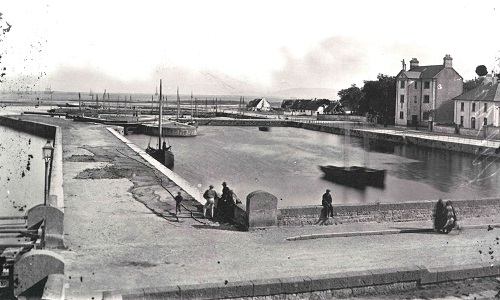The construction of the Claddagh Basin

by Tom Kenny
On January 1, 1848, Samuel U Roberts was appointed district engineer of the Districts of Lough Corrib. He spent the early part of that year making necessary preparations and arrangements and started navigational works in Galway on March 8, having taken possession of some of the lands required for the Eglinton Canal.
In a report to the Board of Public Works in 1848, he wrote of the start of the work on the Claddagh Basin: “A large quantity of ashlar stone has been prepared for the lock and tidal basin works in connexion with the canal and some stanks have been formed with a view to carrying on the work as easily as the approaching season will permit.”
In the 1849 report, he wrote: “The exterior wall of the tidal basin has been completed and a secure line of puddle carried around the whole work. The site of the tidal lock and basin has been enclosed, and the necessary excavation is now progressing.”
The 1851 report included the following: “The lock which forms the entrance from the sea to the tidal basin has been built during the last year, the gates and sluices erected and everything in connexion therewith perfected … the progress of that portion of the tidal basin in connexion with the Claddagh wooden bridge has been a work of peculiar difficulty. The channel here is narrow, and it has been necessary to provide for the discharge of the tail-waters of three mills, in addition to which the tides at high water percolated through the made ground on every side rendering it a matter almost of impossibility to unwater the work. The excavation of the western side of this portion of the basin has been completed, the Claddagh quay underpinned and the quay wall between Balls Bridge and the lock at Folan’s Lane raised to the full height and the trackway formed.”
The filling which they dug out was used to fill terraces in UCG which was being built at the time and also to fill in the causeway behind Claddagh Quay.
The tidal basin was 470 feet long, 170 wide, and had 1,000 feet in quayage. It was the entrance from the sea to the Eglinton Canal which was two thirds of a mile long. The ascent to the level of Lough Corrib was accomplished by one lock which was 130 feet long, 21 wide, and with a lift of 14 feet. The deepth of navigation on the canal was 6.5 feet.
For the next 70 years or so, the basin and canal were very busy with a lot of commercial traffic moving between the sea and the lake. The bridges on the canal could all be opened to allow boats through, but as the levels of traffic decreased, it was decided to replace these moveable bridges with permanent fixtures. As a result, the Claddagh Basin became much quieter. In recent times that has changed thanks to Bádóirí an Chladaigh increasing their numbers of traditional boats. It is wonderful to see Galway hookers and gleoiteógs moored there. One of the iconic images of Galway last winter was those boats decorated with Christmas lights.
Our photograph, which dates from c1890, was taken from the Fishery Tower.
Tomorrow at 3pm, the latest limestone plaque on the Galway Poetry Trail will be unveiled at the basin just opposite the Claddagh Church. It is a beautiful and evocative poem, a sonnet entitled "Lockdown Aubade" writtten by the distinguished writer Mary O'Malley which was inspired by her first walk out after the lockdown. As she passed the Basin she saw the traditional boats and watched sails being raised. The scene represented freedom to her, escapism and she thought of her father sailing his Claddagh-built gleoiteog off the Conamara coast. The plaque will be unveiled by the well known novelist Donal Ryan and all are welcome to attend.
.png)